Syria fired 40 missiles 'at nothing' after allied air strikes destroyed three Assad chemical sites

The Assad Regime fired 40 defensive missiles at thin air in a failed attempt to save the three Syrian chemical weapons sites destroyed by allied air strikes, the Pentagon said.
A total of 105 missiles rained down on a research centre in Damascus as well as a storage site and a bunker 15 miles west of Homs at 4am Syrian time.
Britain launched eight Storm Shadow cruise missiles from the sky as the US and France provided support from the sea and jets.
France fired 12 cruise missiles, three from a frigate and nine from aircraft, while the US provided the bulk of the firepower with 85 missiles in total.
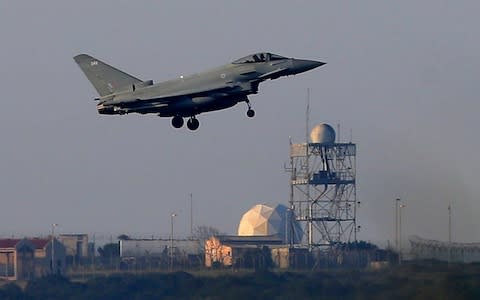
The attack targeted Syria from all angles, with ships and submarines firing from the Red Sea, North Arabian Gulf and the Eastern Mediterranean and jets which took off from Cyprus, France and, reportedly, Qatar.
Addressing the media in Virginia, Lt. Gen. Kenneth McKenzie Jr, the director of joint staff, said he would pick three words to describe the attack: “Precise, overwhelming and effective".
He said Syria had launched 40 surface-to-air missiles in an attempt to shoot the allied weapons down, but that most of them had been fired after the last Syrian target had already been destroyed.
The three bases targeted were the Barzah Research and Development Centre in greater Damascus, the Him Shinshar Chemical Weapons Storage Facility, west of Homs, and the Him Shinshar Chemical Weapons Bunker Facility, just more than four miles from the storage facility.
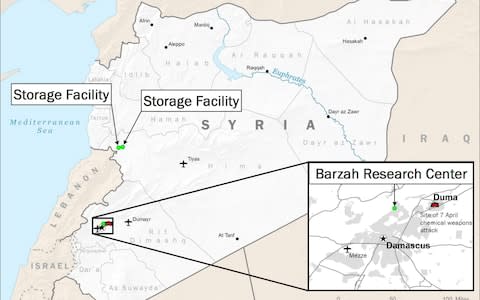
Britain's involvement comprised of the Royal Air Force sending four Tornado GR4s to attack the Him Shinshar Chemical Weapons Storage Facility.
With a maximum speed of Mach 1.3 and capable of carrying more than eight tonnes of weapons, the GR4 is the latest phase in the evolution of the Tornado - the RAF's strike aircraft of choice for the last three decades.
The GR4s involved in the overnight attack deployed eight "bunker busting" Storm Shadow cruise missiles.
Weighing in at 2,866lb (1,300kg), measuring 16.7ft (5.1m) in length and with a range in excess of 150 miles (240km), it has been described by the air force as "arguably the most advanced weapon of its kind in the world".
The range means that none of the GR4s would have been required to cross into Syrian airspace to launch the assault and they were provided with air support by four Typhoons.
Intervention in Syria | Read more
Watch news, TV and more on Yahoo View.
Meanwhile, the French scrambled Mirage and Rafale fighter jets for their part in the Syrian air strikes together with four frigate warships, launching a total of 12 cruise missiles.
The multi-purpose Rafale is used for reconnaissance, ground support as well as air strikes. It is capable of carrying missiles of a similar capability to the Storm Shadows used by the UK.
Alongside the Rafale, France deployed its supersonic Mirage 2000 fighter jets - which have a maximum speed of Mach 2.
Both jets have the capacity to carry missiles capable of reaching their Syrian targets without entering Syrian airspace.
Syria: timeline of British involvement since 2013
The Americans deployed their B-1B Lancer bombers for the strike and also launched missiles from the Ticonderoga-class cruiser Monterey, the Virginia-class submarine John Warner, and two other warships.
In total, the US launched 66 Tomahawk missiles, and 19 joint air-to-surface stand-off missiles.
Nicknamed "the Bone", the B1-B is capable of carrying the most weapons of any bomber in a modern air force.
It is prized for its speed, manoeuvrability and long range.
Like the jets deployed by France and Britain, the B1-Bs would not have been required to cross into Syrian airspace to strike.
Earlier this month, the US Air Force released footage of two B-1Bs arriving at the Al Uldeid air base in Qatar.
The Barzah facility was hit by 76 US missiles in total, the storage facility was hit by 22 weapons from all three nations and seven French missiles fell on the bunker.
Earlier, Russia had claimed its Syria's Cold War era air defence system shot down 71 of the missiles launched by the US, Britain and France in retaliation for Bashar al-Assad's attack on civilians in Douma last Saturday.

The US's top general played down the Syrian response, and asked if there had been any Russian retaliation, General Dunford said: "We did have some initial surface-to-air missile activity from the Syrian regime. That's the only retaliatory action we're aware of at this time.
"We've completed the targets that were assigned to the United States central command. Those operations are complete."
He added: "We specifically identified these targets to mitigate the risk of Russian forces being involved. We did not do any co-ordination with the Russians on the strikes, nor did we pre-notify them."
Syrian state media had earlier claimed to have shot down 13 cruise missiles, but Defence Secretary Gavin Williamson told BBC Radio 4's Today programme that last night's air strike against the Syrian regime was "a highly successful mission".

He said: "The reason we have taken this action is because we all saw the images last week of the suffering that had been inflicted on innocent men, women and children, and there has been a need to act.
"That's why last night we deployed four Tornados armed with Storm Shadow cruise missiles. You will be pleased to hear all of those crews have returned safely and every early indication is that is has been a highly successful mission.
"This is something we have been in discussion with the US and French over the last few days but obviously the meeting of Cabinet is where this was properly discussed."
Mr Williamson said the service personnel involved in last night's attack have played "an important role in terms of degrading the Syrian regime in using chemical weapons in the future".
Russia had boasted of its S-400 surface-to-air defence system, but it does not appear to have been used in the overnight strikes in Syria.
Great Britain's arsenal in the Syrian conflict
Tornado GR4
The Tornado has been carrying out air strikes in Syria and Iraq over the past few years.
Set to be retired from service next year, after almost four decades on operations, the Tornado, with a maximum speed of Mach 1.3, has also seen action in Libya, Afghanistan and Iraq.
It can be loaded with a mix of weapons which include Paveway II, III and IV series GPS/laser-guided bombs, Brimstone air-to-ground missiles and Storm Shadow air-launched long-range strike missiles.
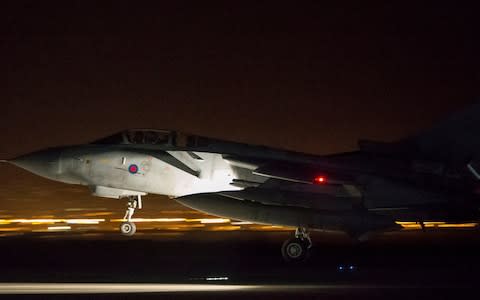
The main Tornado squadrons are based at RAF Marham in Norfolk, which will become the new home of the cutting-edge of the F-35 Lightning stealth fighter jets.
There are currently six of the jets based at RAF Akrotiri, Cyprus, a location some 315 miles (510km) from Syria.
Eurofighter Typhoon
With a maximum speed of Mach 1.8, the Eurofighter Typhoon was first deployed in combat in Libya in 2011, and is also the jet used for Britain's Quick Reaction Alert squadrons based at RAF Lossiemouth, Scotland, and RAF Coningsby, Lincolnshire, with a presence also in the Falkland Islands.
Typhoons are armed with an internal 27mm Mauser cannon, plus Advanced Short Range Air-to-Air Missiles, as well as Enhanced Paveway II and Paveway IV precision-guided bombs. Future weapons on the jet will also include Storm Shadow and Brimstone, as well as Meteor air-to-air missiles.
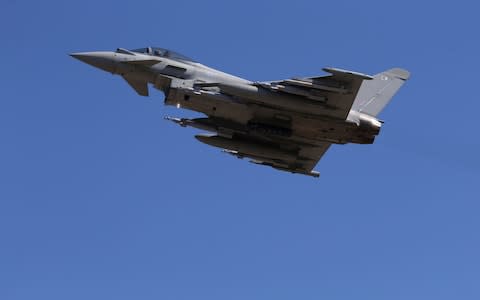
There are currently eight of the jets based at RAF Akrotiri in Cyprus, used in the air campaign against Islamic State in Iraq and Syria.
Submarines
Another potential option could be to use Tomahawk cruise missiles launched from Royal Navy attack submarines.
British submarines have been equipped with the missiles since the late 1990s.
The Tomahawk IV has a range of well over 1,000 miles (1,610km) and can be redirected to a new target in mid-flight - it is known as a strike first weapon and could be a likely option for use in Syria as they can be launched unalerted.
Used during operations in Afghanistan, Libya and Iraq in 2003, it is understood there is always a submarine available to be deployed for such tasks, and one could be sent to the Eastern Mediterranean should it be required.
Storm Shadow cruise missiles
Described as a "long-range deep-strike weapon" by MBDA systems, which produces the missile, the company states on its website that it is "designed to meet the demanding requirements of pre-planned attacks against high-value fixed or stationary targets".
Weighing in at 2,866lb (1,300kg), measuring 16.7ft (5.1m) in length and with a range in excess of 150 miles (240km), it is operated from Tornado jets and in future will be carried on Eurofighter Typhoon.

The long-range air-to-surface missile, designed as a "bunker buster", is understood to be the weapon likely to be used if allied military intervention in Syria is agreed upon, and could be useful to potentially penetrate underground chemical weapon stockpiles.
It was first brought into service in 2003 and has previously been described by the RAF as "arguably the most advanced weapon of its kind in the world".
Paveway bombs
The RAF said Paveway IV "offers huge tactical flexibility", and, as the impact angle and direction can be programmed from the cockpit, it gives a "precisely tailored strike on planned and unplanned targets".
As an air-to-surface weapon it offers improvements over older weapons, including greater accuracy.
It requires no maintenance, has a higher resistance to GPS jamming and a lower cost. But to be effective, the jet carrying it has to be over or within vicinity of the target, which could mean the aircraft it is being launched from becomes vulnerable to surface-to-air retaliatory missiles or fire.
Brimstone
Noted as a "precision attack weapon" by Stevenage-based MBDA, the company said Brimstone can be used to target fast-moving vehicles, tanks, armoured cars and bunkers, as well as naval vessels.
Each missile weighs 110lb (50kg), measures 6ft (1.8m) and is 7in (180mm) in diameter, and is a short-range missile.
The weapons Donald Trump has at his disposal to attack the Assad Regime
Tomahawk cruise missiles
The Tomahawk IV has a range of well over 1,000 miles and can be redirected to a new target in mid-flight - it is known as a strike first weapon and is a likely option for use.
Manufactured by Raytheon, the company states on its website that the cruise missile can "circle for hours, shift course instantly on command and beam a picture of its target to controllers".
With an ability to be launched from ships or submarines, the weapon can "fly into heavily defended airspace" and at extremely low altitudes, according to Raytheon.
The US has previously launched Tomahawk missiles at targets in Syria, including 59 on Shayrat air base in April last year from US Navy destroyers, USS Ross and USS Porter.
US, UK and French launch Syria airstrikes, in pictures
The strike targeted the airfield, warplanes and hangars on the base, south-east of the city of Homs, following an alleged sarin gas attack on civilians.
Tomahawks each weigh 3,300 lbs (1500 kg) with a rocket motor, and can travel at the subsonic speed of 550 mph.
In 2004 the British Government agreed a £70 million deal with the United States government to purchase 64 upgraded Tomahawk missiles.
Raytheon said the Tomahawk is a "highly-accurate, GPS-enabled precision weapon", which has been used more than 2,000 times by the US and allied militaries.
The US Navy states on its website that the primary function of the missiles is for "striking high value or heavily defended land targets".
It has been reported that two US cruise missile destroyers, armed with Tomahawks, have been dispatched or are already in the region, ready for if military action is given the go ahead.
F-16 fighter jets
There are a number of the aircraft at Incirlik Air Base in Turkey which have been supporting global coalition efforts to eradicate Islamic State from Syria and Iraq.
Known as the fighting falcon, the US Air Force (USAF) describes the jet on its website as being able to fly more than 500 miles and "delivers its weapons with superior accuracy" and can "defend itself against enemy aircraft".

Described as a multi-role fighter, it can carry a payload which includes the Joint Air-to-Surface Standoff Missile (JASSM), a stealthy missile which uses an infrared seeker, as well as four air-to-air missiles and reach Mach 2 when flying at altitude.
Lockheed Martin, the company behind the JASSM missile, said it is long-range and "designed to destroy high-value, well-defended, fixed and relocatable targets".
B-1 Bomber
The B-1B Lancer is capable of carrying the "largest conventional payload" according to the USAF, and is the "backbone of America's long-range bomber force".
Although the Department of Defence has said it will "not confirm locations of specific assets", in September last year it announced that one of the aircraft had flown in a mission off the North Korean coast amid Kim Jong-un's weapons programme.
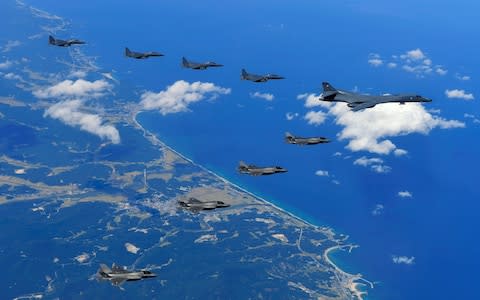
The warplane is capable of being packed with 24 of the long-range Joint Air-to-Surface Staff Missile Extended Range (JASSM-ER), according to the USAF, which has a longer range than the JASSM.
Flying "missions daily in support of continuing operations" according to the USAF, even though it is not known if there are any in the Middle East, it could potentially be deployed if strikes occur.
F-22 Raptor
Built by American aviation giant Lockheed Martin, according to the Department of Defence the stealth fighter jet has "unprecedented survivability and lethality".
It has been reported that America has a number of the warplanes based in Qatar, which have been used in the global coalition effort to eradicate Islamic State - the first use of the jet in a combat role by the US.
According to the USAF, the F-22 "cannot be matched by any known or projected fighter aircraft", and can cruise at supersonic airspeeds greater than Mach 1.5.

In September 2015 the USAF said it had 183 of the jets, with each one costing 143 million dollars (£100 million).
It can carry two 1,000 lb (450 kg) Joint Direct Attack Munition (JDAM) bombs, which "autonomously navigates to the designated target coordinates", the USAF said.
Russia's S-400 surface-to-air defence system - one of the most advanced on the planet
The latest generation in a series of increasingly sophisticated systems, the S-400 is considered one of the most advanced air defence systems in the world, reportedMike Wright, Roland Oliphant and video news producer Charlotte Krol.
It comes equipped with a sophisticated radar and control array that allows it to target dozens of enemy aircraft simultaneously at ranges of up to 250 miles.
And while its missile interceptor capability is shorter range - about 75 miles - its missiles travel at a thousand metres a second and can hit low-flying targets at just a few metres of altitude - perfect for killing sub-sonic Tomahawks.
Russia deployed the S-400 to its Hmeymim airbase in Syria in 2015 after a Turkish jet fighter shot down a Russian bomber.
How Russia's S-400 missile defence system could stand up in Syria
Moscow is believed to have at least one partial battery, consisting of several launchers with up to 60 missiles, at the Hmeymin airbase near Latakia.
It can fire several kinds of missile. The 9M96, which the S-400 generally uses against incoming cruise missiles, has an (official) successful interception rate of about 70 percent, so doctrine calls for two missiles to be fired at each target to guarantee a hit.
But US commanders may plan to overcome that impressive hit rate by firing an overwhelming number of Tomahawks.
"The system should have plenty of capacity to shoot down individual missiles. But it is fairly easy to swamp it just in terms of the sheer number of interceptors required," said Justin Bronk of the Royal United Services Institute.
A strike of the magnitude seen at the Shayrat airbase last year, when 60 Tomahawks were used, would be far beyond the missile capacity of the S-400 battery that we know to be in Syria."
An S-400 versus Tomahawk showdown in Syria would be the first time the systems have been properly tested against one another - and could have a profound impact on military thinking in Moscow and Washington.
"The performance of the S-400 would be very significant for Nato. The system is feared in Europe and Kaliningrad. If it was shown to be incapable of stopping significant numbers of Tomahawks it would have implications for Russia's deterrence capability," said Mr Bronk.
"That could be why the Russians refrained from intercepting the Tomahawks fired at Shayrat last year - nothing is more terrifying than the unknown."
They are yet to face off, as it appears Moscow did not deploy the system in the most recent air strikes on the Syrian bases.
At a glance | Sanctions against Russia
Syria's Cold War-era missile interceptors and launchers
S-75 Dvina
Damascus has 320 S-75 Dvina launchers as part of its air defence system designed to combat air strikes.
It is understood the Soviet designed weapons are currently being updated. Since its first deployment in 1957 it became one of the most widely deployed air defence systems in history.
At 2.3 tons, the weapon weighs more than twice that of Great Britain's new missile - the Storm Shadow cruise missile.
S-200
Syria has 48 Soviet-built S-200 missiles which were built back in 1967 and each one measures more than 10 metres.
The S-200 Angara is a long rage, medium-to-high altitude surface-to-air missile system designed in the Soviet Union.
While it is no longer used by the Russian army, it is a vital cog in Bashar al-Assad's military wheel.
The missile's range is impressive, but its reliability has been called into question after two people were killed and one injured after an apparently stolen warhead from the surface-to-air missile exploded at a scrap yard in the Siberian city of Chita.
A criminal investigation was opened into the "illegal acquisition and storage of explosive device" after two warheads from a S-200 Angara missile were found at the blast site.
Douma chemical attack
Local authorities said it appeared that the warhead had detonated while workers were cutting it down for scrap metal.
On Saturday morning, The Kremlin revealed it was considering supplying the updated S-300 missile systems to Syria.
In response to the Western strikes, Russia threatened to give Syria and other allies its advanced S-300 surface-to-air missiles.
Colonel-General Sergei Rudskoi: “A few years ago, considering the insistent requests of some of our Western partners, we decided not to deliver S-300 surface-to-air missile systems to Syria.
"Considering what has happened, we think it's possible to once again consider this question, and not just for Syria, but other countries.”
Half of France's military planes 'unfit to fly'
French warplanes and helicopters may be asked to join the fight against the Assad Regime, but the French Air Force on the whole is in a disastrous state, according to a report by Rory Mulhollandfrom Paris in December.
More than half - 56 per cent - of all France's aircraft were deemed unfit to fly at any given moment, according to a senior minister.
“If I compare the current situation … of our planes with a car, it is as if I wanted to have a car every morning that works, I would have to own four cars,” Florence Parly, the armed forces minister, said during a visit to an air base in Evreux in Normandy in December.
She made the remark in a scathing speech about the state of the French fleet, where aircraft availability has gone from bad to worse despite a 25 per cent boost to the maintenance budget over the past five years that brought the total to €4 billion (£3.5 billion) in 2017.
Ms Parly went to Evreux to announce wide-ranging plans to cut soaring costs and free up more aircraft by streamlining the current maintenance programme, which is so complex that it can take 30 different contracts to get a helicopter repaired.
Britain’s Royal Air Force, whose aircraft have been in constant use for many years in Afghanistan and Iraq, was criticised earlier last year when it was revealed that on average one in three of its multi-role Typhoon fighters and Tornado combat jets was unfit to fly.
Overall figures for the air readiness of the RAF fleet are not publicly available, but the figures for its fighter jets suggest that it is in far better shape than its French counterpart.
Eighty per cent of the French fleet is operational in the battle zones of west Africa, Iraq and the Middle East, according to official figures in December, but in bases in France the figure plummeted to 30 per cent.
The overall figure for aircraft ready to fly stood at 44 per cent, down from 55 per cent in 2000.
On average, just one Caracal - a long-range tactical transport helicopter - in four was ready for action, while just one or two A400M turboprop transport planes out of a total of twelve were ready to take to the air.

The Rafale, which is seen as one of the best multi-purpose fighter jets in the world, scored a respectable 49 per cent availability.
But the figures for a range of other aircraft were disastrous: 22 per cent for the C-130 transport plane, 25 per cent for the Tiger attack and reconnaissance helicopter, and 26 per cent for the Lynx helicopter.
“The consequences of this are that (flight) teams train less … and the cost of an hour of flight time has gone up,” Ms Parly said at the time
An hour of flight time for a Caracal, for example, rose from €19,000 in 2012 to €34,000 in 2016.
“This situation is no longer tenable, and I have therefore made it a personal priority,” said the minister.
She announced that a new aeronautic maintenance department would be set up in March but that there would be no increase in the maintenance budget as it was deemed sufficient if the process was properly reorganised.
The planned department, whose boss will report to the joint chief of staff, would make the company that makes the aircraft responsible for their maintenance “from start to finish,” Ms Parly said.
The aim is to avoid the case of the Tiger helicopter, whose maintenance is currently split between so many different firms or military offices that it requires more than 30 separate contracts.
Profile | Bashar al-Assad
Pierre Tran, a specialist on French military issues, said at the time in theory the minister’s plans were sound but that in practice there was a high risk.
“They (defence contractors) will likely be thinking that Christmas came early this year,” he said, noting that the huge sums involved meant that there was a high risk of taxpayers’ money being wasted.
The key to success for the government is to exercise extreme caution when negotiating the new maintenance contracts with the firms involved, which include Airbus, Dassault, Thales and Air France Industries, said Mr Tran.
In a message clearly directed at aircraft makers, the Armed Forces Minister said she wanted results by 2020.
“We buy to fly, not to stock planes in hangars or parking spots,” said Ms Parly.
